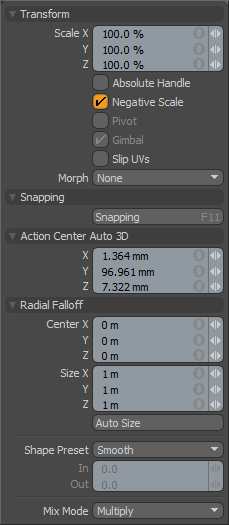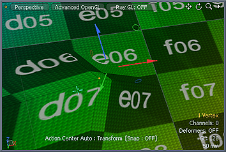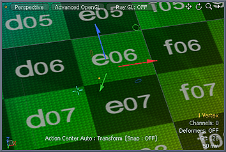Bulge

The Bulge tool combines the Transform Scale tool with a Radial Falloff to produce a swelling effect on the target object or surface. You apply this tool similar to applying any normal scaling transform, but this tool smoothly fades the effects of the scaling across the object or surface.
Usage

The Bulge tool is in the Deform sub-tab of the modeling toolbox. (You can also choose Edit > Deform > Bulge.) Clicking the tool's button activates the tool. Next, click in the 3D viewport to enable the tool's interactive editing mode and for the Bulge tool to create an automatic falloff. Modo places the center of this falloff at the intersection of the pointer and the Work Plane, and Modo determines its size by the bounding box of the target element relative to the center. In some cases, this might not be the desired behavior; therefore, when the tool is active, you can manually position the falloff by right-clicking and dragging in the 3D viewport.
When you first activate the tool, Modo automatically fits the radial falloff to the current geometry and activates the Stretch tool at the center of the mesh. You use the Stretch handles to cause an apparent bulging of the object. To define a custom area of the mesh for applying the bulge, right-click and drag to set the Radial falloff region. Clicking applies the Stretch tool.
|
Bulge |
|||||
|---|---|---|---|---|---|
|
Transform |
|||||
|
Scale X/Y/Z |
Displays specific scaling values applied to the geometry. You can enter specific values or adjust in the viewport. When adjusting an object interactively in the viewport, the Scale input values indicate the current scale factor applied. |
||||
|
Absolute Handle |
When enabled, applies an additional function to the tool handles for you to scale the handle itself without affecting the transform amount. In some cases this provides finer control over very large or very small adjustments. |
||||
|
Negative Scale |
When enabled, applies negative scale values, if appropriate, when you manipulate the tool handles in the viewport. When disabled, Modo does not automatically change the values if they are negative. You can always input negative values directly. |
||||
|
Pivot |
Disabled for the Bulge tool. |
||||
|
Gimbal |
Disabled for the Bulge tool. |
||||
|
Child Compensate |
(Only available in Items mode) When enabled, ignores any transform values for child items. When disabled, passes along transform values to any child items of the current selection. |
||||
|
Slip UVs |
(Only available in Component modes) When enabled, edits applied to the geometry do not change the existing UV map. UV values are generally fixed to specific vertices; therefore, further edits to the geometry may warp, deform, or otherwise distort the UV values in undesirable ways. When this happens, you may need to adjust the map or to redo it altogether. To avoid this undesirable result, you enable Slip UVs so as to not disturb any existing UV mapping applied to the geometry.
|
||||
|
Morph |
(Only available in Component modes) Determines how Modo treats stored morphing information when applying transforms (such as the Move, Rotate, or Scale transforms) to geometry. There are three options for controlling how Modo deals with the morph map vertex data when applying any transforms. • None - Transforms selected (visible) morphs independent of their source, but does not affect unselected morph data.
• Transform - Transforms morph data along with the base mesh.
• Keep Positions - Converts morph data into an absolute morph map. All vertices retain their pre-transformed positions. Note: In previous versions of Modo, to transform a morph along with its base, you needed to select it in the Vertex Map list. If you didn't, when Modo recalled the relative morph map data, it would produce distorted, undesirable results; therefore, it was easy to accidentally spoil a model. To remedy this problem, current versions of Modo have three options to deal with the morph map vertex data. |
||||
|
Snapping |
See the Applying Snapping topic for details about this feature. |
||||
|
Radial Falloff |
|||||
|
Center X/Y/Z |
Defines the center of influence, which is where the strength of the falloff is the greatest (100%). The strength of the falloff attenuates toward the outer bounds of the spherical volume. The area outside the volume receives no tool influence (0%). |
||||
|
Size X/Y/Z |
Defines the radius of a circle from the Center position and determines the outer area of the falloff where there is no effect. |
||||
|
Auto Size |
Adjusts the falloff's Center and Size values automatically to match the bounding box of the current selection. |
||||
|
Shape Preset |
Controls the strength of the falloff's influence along the extent by using a shape preset. • Linear - Attenuates the falloff evenly across its range.
• Ease-In - Strengthens the falloff toward the start position.
• Ease-Out - Strengthens the falloff toward the end position.
• Smooth - Strengthens the falloff toward the center of the falloff.
• Custom - Fine tunes the strength of the falloff based on the In and Out values. |
||||
|
In/Out |
Determines the strength of the falloff nearer to the start or end position. |
||||
|
Mix Mode |
Defines how each falloff interacts with the other(s) in instances where there are multiple falloffs applied to a transform (by using Add in the Falloff menu). |
||||


